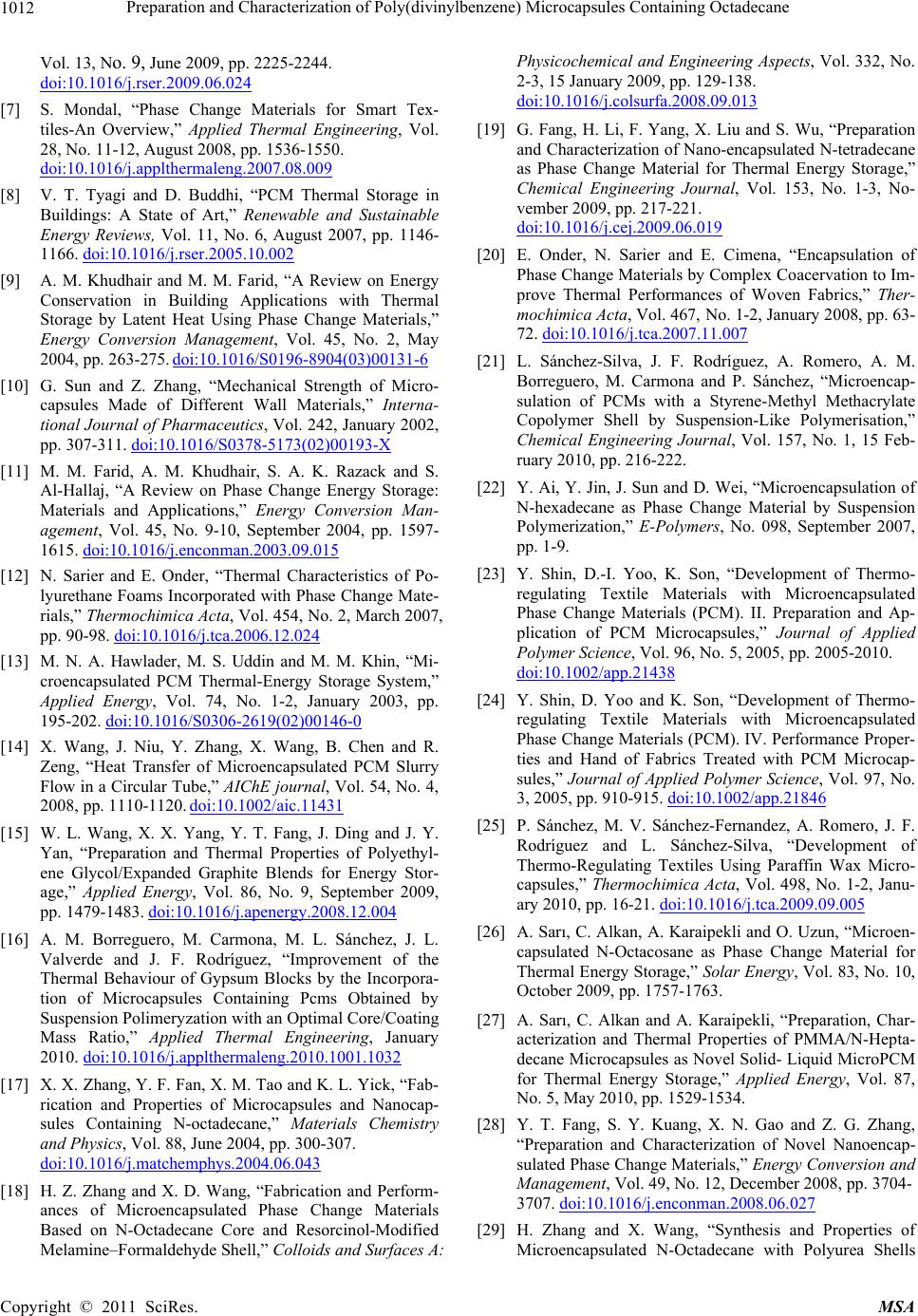
Preparation and Characterization of Poly(divinylbenzene) Microcapsules Containing Octadecane
1012
Vol. 13, No. 9, June 2009, pp. 2225-2244.
doi:10.1016/j.rser.2009.06.024
[7] S. Mondal, “Phase Change Materials for Smart Tex-
tiles-An Overview,” Applied Thermal Engineering, Vol.
28, No. 11-12, August 2008, pp. 1536-1550.
doi:10.1016/j.applthermaleng.2007.08.009
[8] V. T. Tyagi and D. Buddhi, “PCM Thermal Storage in
Buildings: A State of Art,” Renewable and Sustainable
Energy Reviews, Vol. 11, No. 6, August 2007, pp. 1146-
1166. doi:10.1016/j.rser.2005.10.002
[9] A. M. Khudhair and M. M. Farid, “A Review on Energy
Conservation in Building Applications with Thermal
Storage by Latent Heat Using Phase Change Materials,”
Energy Conversion Management, Vol. 45, No. 2, May
2004, pp. 263-275. doi:10.1016/S0196-8904(03)00131-6
[10] G. Sun and Z. Zhang, “Mechanical Strength of Micro-
capsules Made of Different Wall Materials,” Interna-
tional Journal of Pharmaceutics, Vol. 242, January 2002,
pp. 307-311. doi:10.1016/S0378-5173(02)00193-X
[11] M. M. Farid, A. M. Khudhair, S. A. K. Razack and S.
Al-Hallaj, “A Review on Phase Change Energy Storage:
Materials and Applications,” Energy Conversion Man-
agement, Vol. 45, No. 9-10, September 2004, pp. 1597-
1615. doi:10.1016/j.enconman.2003.09.015
[12] N. Sarier and E. Onder, “Thermal Characteristics of Po-
lyurethane Foams Incorporated with Phase Change Mate-
rials,” Thermochimica Acta, Vol. 454, No. 2, March 2007,
pp. 90-98. doi:10.1016/j.tca.2006.12.024
[13] M. N. A. Hawlader, M. S. Uddin and M. M. Khin, “Mi-
croencapsulated PCM Thermal-Energy Storage System,”
Applied Energy, Vol. 74, No. 1-2, January 2003, pp.
195-202. doi:10.1016/S0306-2619(02)00146-0
[14] X. Wang, J. Niu, Y. Zhang, X. Wang, B. Chen and R.
Zeng, “Heat Transfer of Microencapsulated PCM Slurry
Flow in a Circular Tube,” AIChE journal, Vol. 54, No. 4,
2008, pp. 1110-1120. doi:10.1002/aic.11431
[15] W. L. Wang, X. X. Yang, Y. T. Fang, J. Ding and J. Y.
Yan, “Preparation and Thermal Properties of Polyethyl-
ene Glycol/Expanded Graphite Blends for Energy Stor-
age,” Applied Energy, Vol. 86, No. 9, September 2009,
pp. 1479-1483. doi:10.1016/j.apenergy.2008.12.004
[16] A. M. Borreguero, M. Carmona, M. L. Sánchez, J. L.
Valverde and J. F. Rodríguez, “Improvement of the
Thermal Behaviour of Gypsum Blocks by the Incorpora-
tion of Microcapsules Containing Pcms Obtained by
Suspension Polimeryzation with an Optimal Core/Coating
Mass Ratio,” Applied Thermal Engineering, January
2010. doi:10.1016/j.applthermaleng.2010.1001.1032
[17] X. X. Zhang, Y. F. Fan, X. M. Tao and K. L. Yick, “Fab-
rication and Properties of Microcapsules and Nanocap-
sules Containing N-octadecane,” Materials Chemistry
and Physics, Vol. 88, June 2004, pp. 300-307.
doi:10.1016/j.matchemphys.2004.06.043
[18] H. Z. Zhang and X. D. Wang, “Fabrication and Perform-
ances of Microencapsulated Phase Change Materials
Based on N-Octadecane Core and Resorcinol-Modified
Melamine–Formaldehyde Shell,” Colloids and Surfaces A:
Physicochemical and Engineering Aspects, Vol. 332, No.
2-3, 15 January 2009, pp. 129-138.
doi:10.1016/j.colsurfa.2008.09.013
[19] G. Fang, H. Li, F. Yang, X. Liu and S. Wu, “Preparation
and Characterization of Nano-encapsulated N-tetradecane
as Phase Change Material for Thermal Energy Storage,”
Chemical Engineering Journal, Vol. 153, No. 1-3, No-
vember 2009, pp. 217-221.
doi:10.1016/j.cej.2009.06.019
[20] E. Onder, N. Sarier and E. Cimena, “Encapsulation of
Phase Change Materials by Complex Coacervation to Im-
prove Thermal Performances of Woven Fabrics,” Ther-
mochimica Acta, Vol. 467, No. 1-2, January 2008, pp. 63-
72. doi:10.1016/j.tca.2007.11.007
[21] L. Sánchez-Silva, J. F. Rodríguez, A. Romero, A. M.
Borreguero, M. Carmona and P. Sánchez, “Microencap-
sulation of PCMs with a Styrene-Methyl Methacrylate
Copolymer Shell by Suspension-Like Polymerisation,”
Chemical Engineering Journal, Vol. 157, No. 1, 15 Feb-
ruary 2010, pp. 216-222.
[22] Y. Ai, Y. Jin, J. Sun and D. Wei, “Microencapsulation of
N-hexadecane as Phase Change Material by Suspension
Polymerization,” E-Polymers, No. 098, September 2007,
pp. 1-9.
[23] Y. Shin, D.-I. Yoo, K. Son, “Development of Thermo-
regulating Textile Materials with Microencapsulated
Phase Change Materials (PCM). II. Preparation and Ap-
plication of PCM Microcapsules,” Journal of Applied
Polymer Science, Vol. 96, No. 5, 2005, pp. 2005-2010.
doi:10.1002/app.21438
[24] Y. Shin, D. Yoo and K. Son, “Development of Thermo-
regulating Textile Materials with Microencapsulated
Phase Change Materials (PCM). IV. Performance Proper-
ties and Hand of Fabrics Treated with PCM Microcap-
sules,” Journal of Applied Polymer Science, Vol. 97, No.
3, 2005, pp. 910-915. doi:10.1002/app.21846
[25] P. Sánchez, M. V. Sánchez-Fernandez, A. Romero, J. F.
Rodríguez and L. Sánchez-Silva, “Development of
Thermo-Regulating Textiles Using Paraffin Wax Micro-
capsules,” Thermochimica Acta, Vol. 498, No. 1-2, Janu-
ary 2010, pp. 16-21. doi:10.1016/j.tca.2009.09.005
[26] A. Sarı, C. Alkan, A. Karaipekli and O. Uzun, “Microen-
capsulated N-Octacosane as Phase Change Material for
Thermal Energy Storage,” Solar Energy, Vol. 83, No. 10,
October 2009, pp. 1757-1763.
[27] A. Sarı, C. Alkan and A. Karaipekli, “Preparation, Char-
acterization and Thermal Properties of PMMA/N-Hepta-
decane Microcapsules as Novel Solid- Liquid MicroPCM
for Thermal Energy Storage,” Applied Energy, Vol. 87,
No. 5, May 2010, pp. 1529-1534.
[28] Y. T. Fang, S. Y. Kuang, X. N. Gao and Z. G. Zhang,
“Preparation and Characterization of Novel Nanoencap-
sulated Phase Change Materials,” Energy Conversion and
Management, Vol. 49, No. 12, December 2008, pp. 3704-
3707. doi:10.1016/j.enconman.2008.06.027
[29] H. Zhang and X. Wang, “Synthesis and Properties of
Microencapsulated N-Octadecane with Polyurea Shells
Copyright © 2011 SciRes. MSA